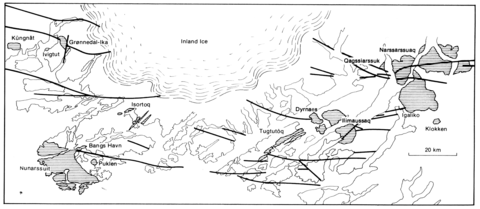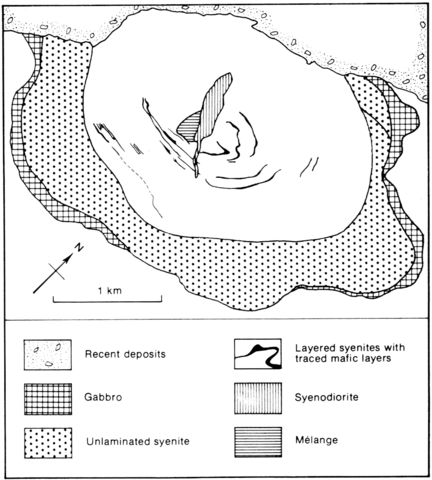stripes
One of the smallest Gardar intrusions, Klokken is an oval stock with sharp, near vertical contacts, which show evidence of upward closure in the form of overhanging roof pendants against granite gneiss. The northern part of the intrusion is hidden beneath Recent gravels. A narrow discontinuous marginal alkali gabbro, which widens downwards and is absent at the highest topographic levels, is succeeded inwards by unlaminated syenite. At high levels also the gabbro grades rapidly, but without a discernable intrusive junction, into syenogabbro and unlaminated syenites, but at low levels there is a break. Over a few hundred metres inward-dipping layering develops and passes into a spectacular layered syenite series (Parsons, 1979, Fig. 1) forming a series of cones with inward dips of 30-50°. Textural and well developed mineral layers, including inversely graded layers, occur and a detailed account of the complex textures and structures is given by Parsons (1979) and of sedimentary-like features by Parsons and Butterfield (1981, p. 294). The layered syenites are cut by a small body of augite-biotite syenodiorite. Aplites and aegirine-arfvedsonite-quartz-alkali feldspar pegmatites cut the layered series and syenodiorite. Plagioclase in the gabbro and syenogabbro dies out in the syenites and is replaced by alkali feldspar. Clinopyroxene occurs in all rocks and varies widely in composition, aegirine being confined to late quartz syenites. Olivine varies from Fa 48-98, the more iron-rich varieties occurring in the laminated syenites. Biotite is present in most rocks but amphibole is present only in the more fractionated syenites varying from sodic hastingsites to varieties between katophorite and arfvedsonite in late quartz syenites. Ilmenite and titanomagnetite occur throughout. Details of mineralogy, rock chemistry, geothermometry and geobarometry and a discussion of cryptic variation and magma evolution will be found in Parsons (1979 and 1981), detailed studies of perthite in Parsons and Brown (1983) and Brown et al. (1983), and of the trace and minor element chemistry of feldspars in Mason et al. (1985).
BLAXLAND, A.B. and PARSONS, I. 1975. Age and origin of the Klokken gabbro-syenite intrusion, South Greenland: Rb-Sr study. Bulletin of the Geological Society of Denmark, 24: 27-32.
BROWN, W.L., BECKER, S.M. and PARSONS, I. 1983. Cryptoperthites and cooling rate in a layered syenite pluton: a chemical and TEM study. Contributions to Mineralogy and Petrology, 82: 13-25.
MASON, R.A., PARSONS, I. and LONG, J.V.P. 1985. Trace and minor element chemistry of alkali feldspars in the Klokken layered syenite series. Journal of Petrology, 26: 952-70.
PARSONS, I. 1979. The Klokken gabbro-syenite complex, South Greenland: cryptic variation and origin of inversely graded layering. Journal of Petrology, 20: 653-94.
PARSONS, I. 1981. The Klokken gabbro-syenite complex, South Greenland: quantitative interpretation of mineral chemistry. Journal of Petrology, 22: 233-60.
PARSONS, I. and BROWN, W.L. 1983. A TEM and microprobe study of a two-perthite alkali gabbro: implications for the ternary feldspar system. Contributions to Mineralogy and Petrology, 82: 1-12.
PARSONS, I. and BUTTERFIELD, A.W. 1981. Sedimentary features of the Nunarssuit and Klokken syenites, S Greenland. Journal of the Geological Society, 138: 289-306.


